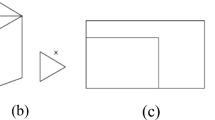Abstract
Science, engineering and mathematics-related disciplines have relied heavily on a researcher’s ability to visualize phenomena under study and being able to link and superimpose various abstract and concrete representations including visual, spatial, and temporal. The spatial representations are especially important in all branches of biology (in developmental biology time becomes an important dimension), where 3D and often 4D representations are crucial for understanding the phenomena. By the time biology students get to undergraduate education, they are supposed to have acquired visual–spatial thinking skills, yet it has been documented that very few undergraduates and a small percentage of graduate students have had a chance to develop these skills to a sufficient degree. The current paper discusses the literature that highlights the essence of visual–spatial thinking and the development of visual–spatial literacy, considers the application of the visual–spatial thinking to biology education, and proposes how modern technology can help to promote visual–spatial literacy and higher order thinking among undergraduate students of biology.
Similar content being viewed by others
References
Allen KW (2000) Learning theories: Bruner Piaget and Vygotsky. The Jean Piaget Society. http://trackstar-dev.scrtec.org/main/display.php3?option=frames&track_id=292. Accessed 15 July 2000
Arcavi A (2003) The role of visual representations in the learning of mathematics. Educ Stud Math 52:215–241
Arnheim R (1986) A please for visual thinking. In: New essays of the psychology of art. University of California Press, Berkeley, pp 135–152
Brown AL, Campione JC, Metz KE, Ash DB (1997) The development of science learning abilities in children. In: Burgen A, Harnquist K (eds) Growing up with science: developing early understanding of science. Academia Europaea, Goteborg, pp 7–40
Cataloglu E, Robinett RW (2002) Testing the development of student conceptual and visualization understanding in quantum mechanics through the undergraduate career. Am J Phys 70(3):238–251
Clement J (1991) Nonformal reasoning in experts and in science students: the use of analogies, extreme cases, and physical intuition. In: Voss JP, Perkins DN, Segal JW (eds) Informal reasoning and education, vol 1. Lawrence Associate Publishers, Hillsdale, pp 345–362
Feynman R (1994) The character of physical law. Modern Library Edition, Random House Inc., New York
Hardin J (2008) The missing dimension in developmental biology education. CBE Life Sci Educ 7:10–11, Spring 2008
Holton G, Brush SG (2001) Physics, the human adventure: from Copernicus to Einstein and beyond, 3rd edn. Rutgers University Press, New Brunswick
Kerski JJ (2008) Developing spatial thinking skills in education and society. ArcWatch: Your e-Magazine for GIS News, Views, and Insights, January
Mathewson JH (1999) Visual-spatial thinking: an aspect of science overlooked by educators. Sci Educ 83(1):33–54. doi:10.1002/(sici)1098-237x(199901)83:1<33::aid-sce2>3.0.co;2-z
Metz KE (1997) On the complex relation between cognitive developmental research and children’s science curricula. Rev Educ Res 67(1):151–163
National Center for Rural Science T, Engineering & Mathematics Education Outreach (2010) Geospatial technology. College of Integrated Science and Technology, James Madison University. http://www.isat.jmu.edu/stem/overview.html. Accessed 11 June 2011
National Research Council (2006) Learning to think spatially: GIS as a support system in the K-12 curriculum. The National Academic Press, Washington
Perkins K, Adams W, Dubson M, Finkelstein N, Reid S, Wieman C, LeMaster R (2006) PhET: interactive simulations for teaching and learning physics. Phys Teach 44:18–23
Piaget J (1926) The language and thought of the child, vol 1. Harcourt Brace, New York
Richardson DC, Richardson JS (2002) Teaching molecular 3-D literacy. Biochem Mol Biol Educ 30(1):21–26
Sommer R (1978) The mind’s eye: imagery in everyday life. Delta Books, New York
Sorby SA (2009) Educational research in developing 3-D spatial thinking for engineering students. Int J Sci Educ 31(3):459–480
Vygotsky L (1978) Mind in society: the development of higher psychological processes, vol 1. Harvard University Press, Cambridge
Ware C (2008) Visual thinking for design. Elsevier, Inc
Watson JD, Crick FHC (1953) Molecular structure of nucleic acid. Nature 171:737–738
Wheeler JA, Taylor EF (1992) Spacetime physics: introduction to special relativity. Freeman, San Francisco
Wieman CE, Perkins KK (2006) Commentary: a powerful tool for teaching science. Nat Phys 2:290–292
Wieman CE, Adams WK, Loeblein P, Perkins KK (2010) Teaching physics using PhET simulations. Phys Teach 48(April):225–227
Conflict of interest
The authors declare that they have no conflict of interest.
Author information
Authors and Affiliations
Corresponding author
Additional information
Handling Editor: Geoffrey Wasteneys
Rights and permissions
About this article
Cite this article
Milner-Bolotin, M., Nashon, S.M. The essence of student visual–spatial literacy and higher order thinking skills in undergraduate biology. Protoplasma 249 (Suppl 1), 25–30 (2012). https://doi.org/10.1007/s00709-011-0346-6
Received:
Accepted:
Published:
Issue Date:
DOI: https://doi.org/10.1007/s00709-011-0346-6




